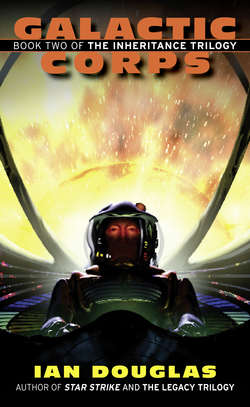Читать книгу Galactic Corps - Ian Douglas, Matthew Taylor - Страница 16
UCS Hermes Stargate Cluster Space 0719 hrs, GMT
ОглавлениеIn General Alexander’s mind, 1MIEF’s battle array resembled a kind of spreading haze of discrete ships, darting and shifting from side to side as they moved. Fleet movements were coordinated by the AI-controlled battlenet, which jinked individual ships to make them harder to target without running afoul of one another. The battlenet could coordinate fire, too, concentrating the volleys from a hundred ships on one Xul monster at a time. Under that kind of intensive bombardment, even the largest, thickest-skinned whale would be whittled down to a cloud of tumbling debris before long.
At the moment, the fleet’s heaviest fire was concentrated on a single Xul Type III, a monster code-named Nightmare-class, a flattened spheroid two kilometers across. White flares of light popped and strobed across the Xul vessel’s hull, pounding at it, battering it, sending gouts and streamers of gas and vaporizing metal spraying into space. A squadron of aerospace fighters were closing with it as well, slamming antimatter warheads into its shuddering bulk.
The vessel was still thirty thousand kilometers off, invisible to the unaided eye, but visible in crystalline detail through the battlenet datafeed, which was drawing in image feeds from several hundred drones spreading through battlespace.
The Nightmare was hurt, trailing plumes of escaping vapor that froze as it hit vacuum into glittering clouds of minute ice crystals. Craters gaped in the monster’s hull, glowing sullen red and orange within the shattered interior. Burn, you bastard, Alexander thought with a silent, fierce intensity. The war with the Xul had been unrelenting and without mercy on either side, a literal war to the death.
A moment later, something inside exploded with savage violence, blowing out a quarter of the Xul warship’s flank. What was left began to fold and crumple in upon itself. Xul ships generated micro black holes as part of their power and drive systems, and when their drive containment fields failed, those singularities tended to eat their way through the ship’s structure, devouring everything with which they came into contact and releasing a flood of hard radiation in their wakes.
Alexander could hear Taggart’s thoughts as the admiral gave orders to the fleet. Another large Xul huntership was being targeted now, as the massed weapons of 1MIEF’s warships shifted to another target—a Type II huntership a kilometer long and thirty-eight thousand kilometers distant. The fleet’s weaponry ran an impressive gamut—high-intensity lasers at both optical and X-ray frequencies, gigavolt plasma discharges, and a wide variety of projectiles and missile warheads—from kinetic kill projectiles to nukes to antimatter charges, with calibers ranging from a few millimeters to several meters. A high-energy storm of devastating warshots began slamming into this new target, scouring and ripping at its ceramic armor like a lightning-charged hailstorm.
However, more and more Xul vessels were moving and beginning to converge on the 1MIEF fleet.
“Ten seconds to expected detonation,” a new voice intoned within Alexander’s head. Then, “Five … four … three … two … one … mark.”
Alexander glanced toward the local star. Bloodstar, the red sun of Cluster Space, continued burning as before, of course, a sullen ember, little more than a pinpoint of ruby light. It would be another ten long minutes before the light from the exploding star reached them.
“Okay, Pappy,” Alexander told the disembodied voice. Pappy was the senior artificial intelligence in 1MIEF, named after an early Marine aviator named Gregory “Pappy” Boyington. “Give me observational data as soon as it’s available. Tag? You heard?”
“I did, General.”
“I suggest we start falling back to the stargate.”
“Affirmative, General.” Alexander heard him begin giving orders, sounding the tactical recall.
This was the tricky part of the operation, getting the forty-two Commonwealth warships that had already come through the stargate, along with over a hundred aerospace fighters and minor combatants, back through to Carson Space without being overwhelmed by the Xul counterattack. The Xul, as the Commonwealth had learned over the years, tended to be cautious. Swat their noses hard enough, and they might not follow up on an enemy raid for years. Still, the toughest part of any op, whether in space or on a planet’s surface, was in the withdrawal phase, when the last few ships or men covering a retreat were left to face overwhelming numbers alone.
The Marines were used to that situation, the Navy less so.
The Xul Type II was collapsing upon itself, now, dwindling with eerie rapidity as the black hole within swallowed it from the inside out. But AI scans of battlespace data indicated that there were as many as two thousand Xul warships in this system. Cluster Space, as was well known, was a major Xul node and operations center.
At the moment, the biggest question was whether or not the Xul would try to follow 1MIEF back through the stargate to Carson Space.
Hermes, largest of the ships of the human fleet, as well as the slowest and most clumsy, completed her reversal maneuver and began making her way back toward the gate.
About her flashed swarms of smaller craft, including the retreating Marines of the initial assault force. Alexander flashed an order to Pappy. “Make sure you track every damned one of those M-CAPs,” he said. “Coordinate the withdrawal with Smedley.”
“Affirmative, General,” Pappy’s calm voice replied. “We will leave no one behind.”
Of course, how the hell did you guarantee something like that? Battlespace was a bewildering soup, of ships large and small, of retreating M-CAPs, of aerospace fighters, Ontos transports, drones, sensor and communications probes, missiles, and drifting chunks of white-hot wreckage. Many of the fighters and Marine assault capsules were damaged, some disabled completely and adrift in emptiness.
But they had to try.
